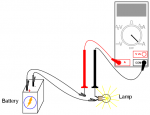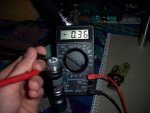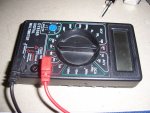- Joined
- Oct 11, 2008
- Messages
- 134
- Points
- 0
THIS IS How to measure current!!!
Hello everyone,
I have noticed that many people new to the hobby and even people new to building thier lasers don't know how to measure current draw with a DMM ( digital multi-meter).
So here is my attempt at a tutorial. If this is a success I hope it will be stickied.
1. get a DMM as seen in the photo.
2. set the dial to "10A", it stands for 10 amps
3.plug the black cord of the DMM into "COM" and the red wire into "10ADC"
that is the DMM set up.
now the easiest way to measure the current on a laser is to take the tail cap OFF the measure from there. Current is always measured in series within the circuit as opposed to parallel. As seen in the diagram
ok now in this case the green laser is case positive so touch the red lead on the DMM to the battery + and the black lead to the case of the laser or the other positive where the battery would normally make contact with, thus completing the circuit.
4. you should have your reading now.
Ex. my reading was0.36 which means 360ma
so there you go that is how to measure current.
Hello everyone,
I have noticed that many people new to the hobby and even people new to building thier lasers don't know how to measure current draw with a DMM ( digital multi-meter).
So here is my attempt at a tutorial. If this is a success I hope it will be stickied.
1. get a DMM as seen in the photo.
2. set the dial to "10A", it stands for 10 amps
3.plug the black cord of the DMM into "COM" and the red wire into "10ADC"
that is the DMM set up.
now the easiest way to measure the current on a laser is to take the tail cap OFF the measure from there. Current is always measured in series within the circuit as opposed to parallel. As seen in the diagram
ok now in this case the green laser is case positive so touch the red lead on the DMM to the battery + and the black lead to the case of the laser or the other positive where the battery would normally make contact with, thus completing the circuit.
4. you should have your reading now.
Ex. my reading was0.36 which means 360ma
so there you go that is how to measure current.
Attachments
Last edited:






